It's 16 weeds and the last of the garden tomatoes. Ripe tomatoes in March? Yes! Come into my post and see!
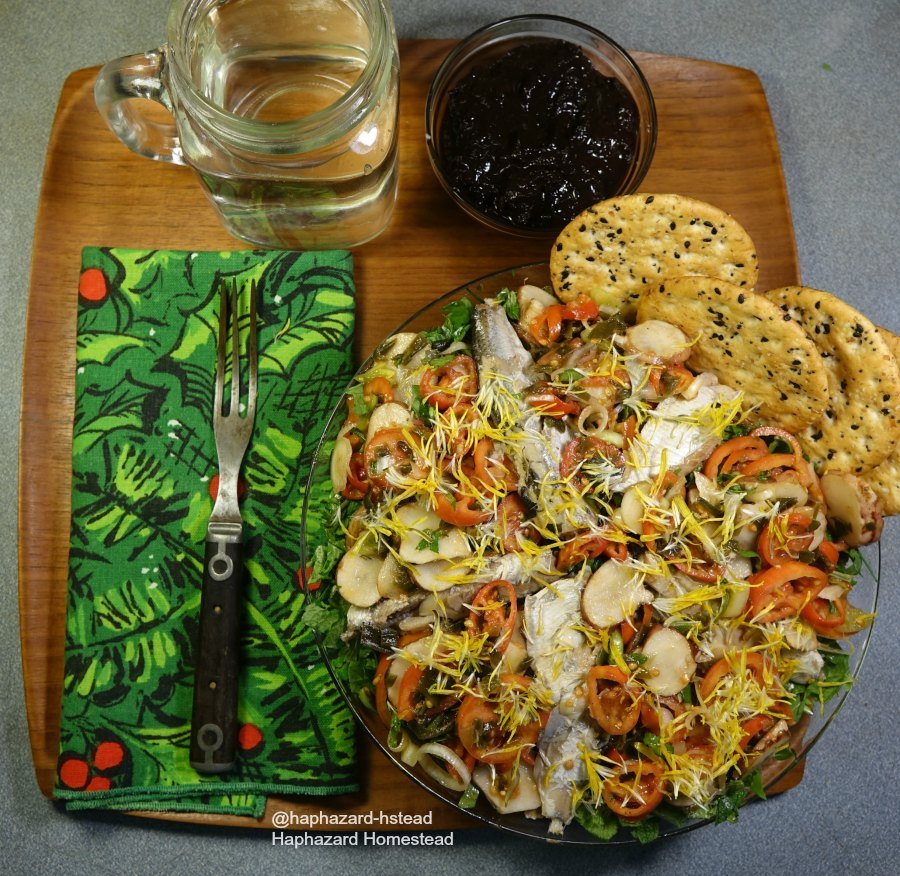
Step 1. Forage the greens
My salad greens all came from my yard. I just took a walk. I took all the photos first, because that takes a lot longer than actually picking everything. This photo collage shows the plants that I foraged. I put their names in a list down at the end of this post. I include the scientific names in the plant list, because common names vary from place to place. Do you recognize any of them? Which ones do you have growing around you? Many of these plants are weeds or garden escape artists and grow all over the world.
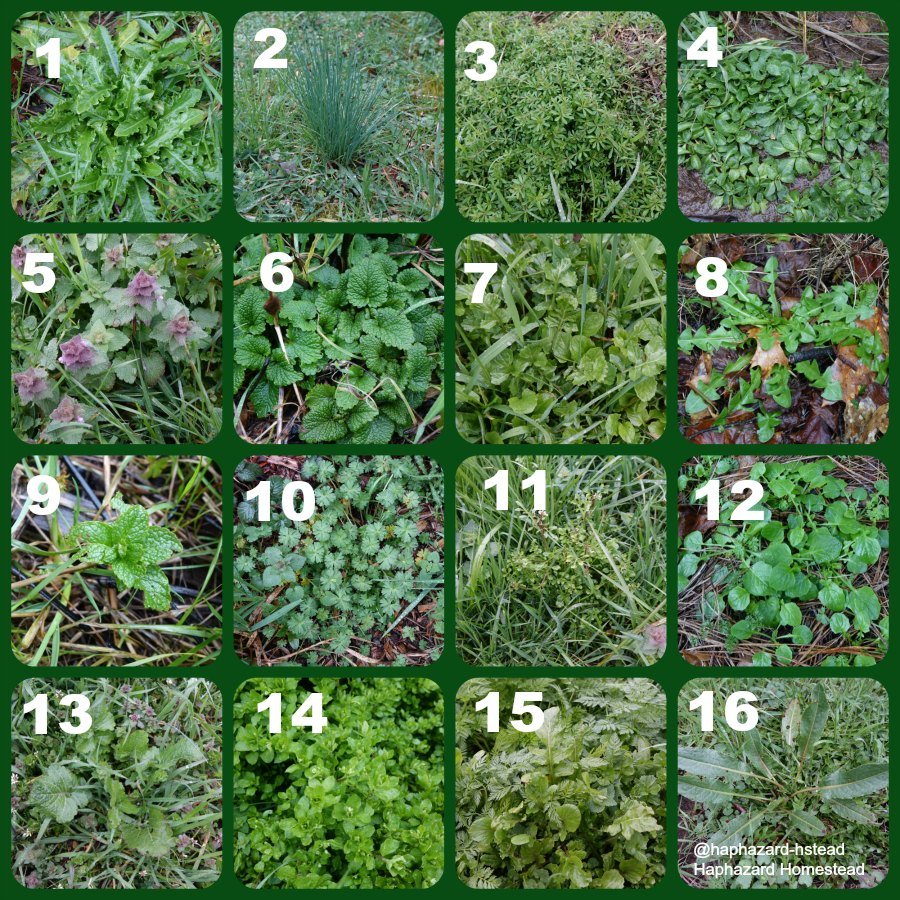
Step 2. Bring the harvest back to the kitchen
Back in the kitchen, I lay all my greens out to double-check that I don't have any non-edible plants. And I cull any poor quality plants. The numbers in these images are different than in the collage above. Can you match the right numbers? Can you recognize any of them? Are any of your favorite wild greens here?

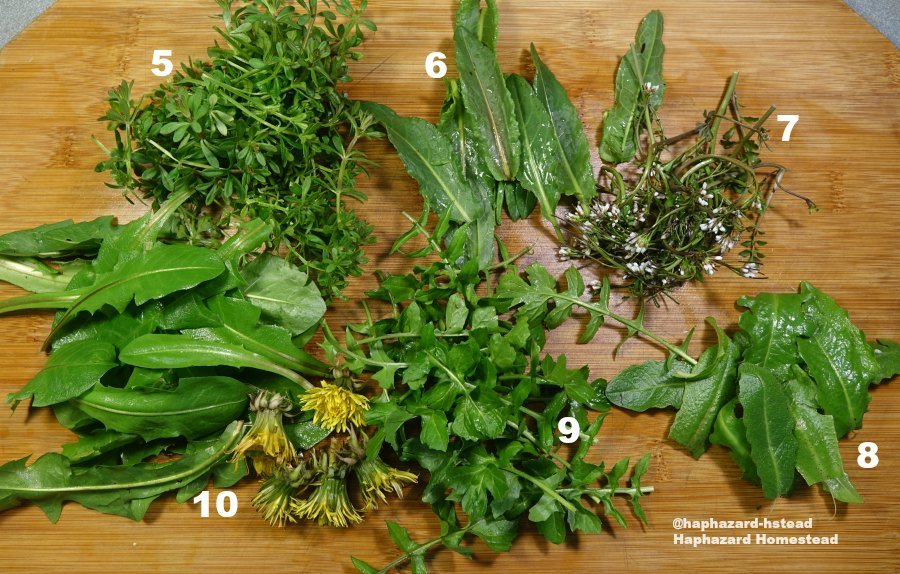
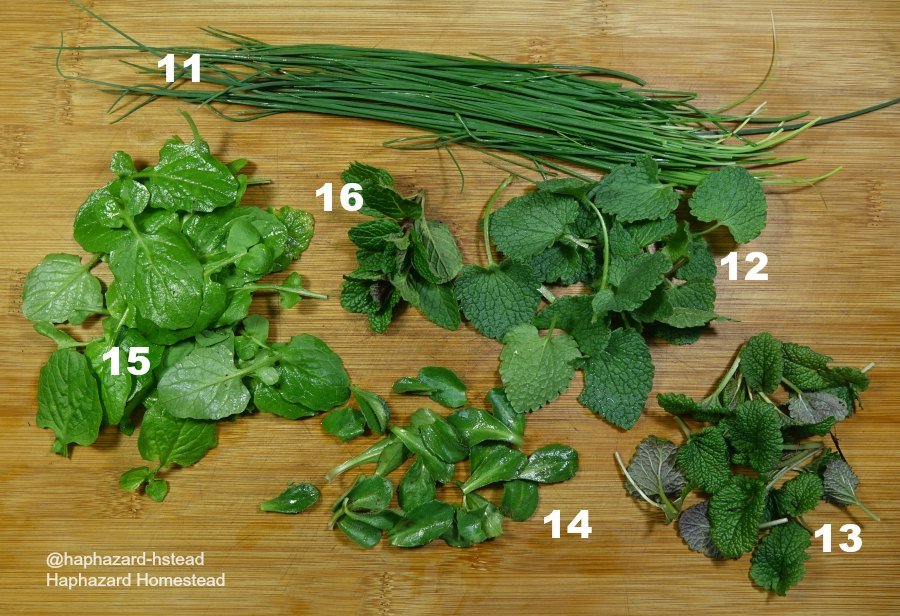
Step 3. Make the Salad
Once I review all my plants, I put all the vegetation in a big pan to rinse them well. With all the winter weather, these plants can have mud and grit on them. And they can have slugs or snails on them, too. So it's important to rinse everything really well.
Then I drain the plants and chop them finely. I don't just chop them once, but a few times over. Chopping up all the greenery is not in fashion at fancy restaurants, but this is what makes a weed salad so tasty. By chopping them so finely, all the flavors mix together. You can see that my big pile of greens ends up a lot smaller in the final pile.

Step 4. Make the Salad Topping
Yes, I still have tomatoes from my garden in 2016. I pull all the tomato plants in October. I take the green tomatoes and put them in carboard trays. I'll write a post with the details soon. But I end up with tomatoes ripening slowly all through the winter. This is the last of my supply, now in March. So this salad is a great way to use up the last of them.
I also went out into my yard and got some garden escape artists: Jerusalem Artichokes and Elephant Garlic. Do not bring those muddy roots back into the kitchen to wash off! NO! Let them soak in some water outdoors and the mud will fall off on its own. Then, and only then, bring them into the kitchen, if you value functional plumbing!
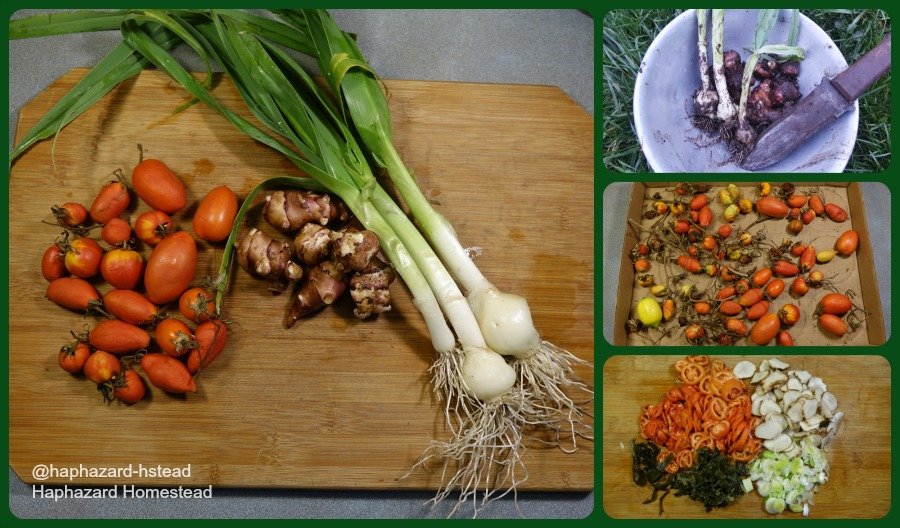
I slice up the tomatoes, the Jerusalem Artichokes and the lower stems of the Elephant Garlic. At this point in the late winter and early spring, Elephant Garlic is more like a Leek, but it's a Spring Leek.
The leaves on the Elephant Garlic are too tough to use directly in a salad now. So I make Fermented Elephant Garlic Leaves. I'll make a post about that soon, too. But it's easy - just leaves and a tiny bit of salt. For this salad, I am using some fermented elephant garlic leaves that I made last year. They are the the dark pile in the lower right of the picture. I finely chop them, but I've left some long in the picture so you can see what they look like.
I put all that in a bowl and poured on some olive oil and added some fresh-cracked black pepper. I let that sit for a couple hours. I forgot to take a picture of all that in the bowl. So you will have to imagine that pile sitting in a bowl.
Step 5. Enjoy a Healthy Salad
Its easy to make this salad. Fill a big bowl with all those greens. Arrange the sardines on top. Add the marinated toppings, finish off with a few crackers. For dessert, I have a little bowl of plum compote that I canned from my homegrown harvest.
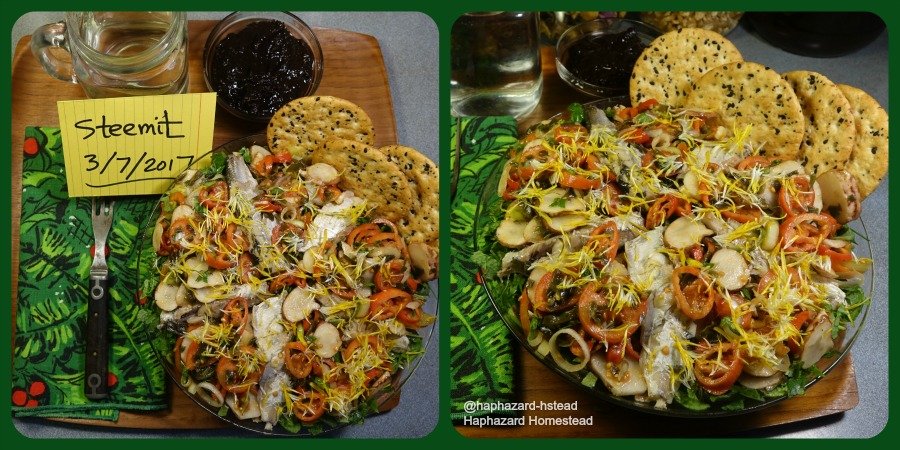
<Ingredients: Weeds, elephant garlic (fresh and leaves fermented), tomatoes, Jerusalem artichokes, olive oil, black pepper, sardines in water.
It may not be the prettiest salad. But it's a great-tasting salad! And you know it is healthy with all those deeply colored greens and the protein from the fish. Would you be better off eating a weed salad every day? I know I would! But spring is almost here - and then it is weed salads every day! Yay!
Plant List
This list goes with the 16-plant collage in section 1. Can you match up these plants with the right numbers in section 2? Put your answers down in the comments. I'll let you know if you are right or not!
- Cats-ear - Hypochaeris radicata - winter leaves are tender and mild
- Wild chives - Allium schoeneprasum - leaves from fall through spring
- Cleavers - Galium aparine - leaves late winter to late spring
- English daisy – Bellis perennis – leaves from fall through early summer
- Purple deadnettle - Lamium purpureum - leaves fall through early spring
- Lemon balm – Melissa officinalis - it lasts from spring through fall
- Hedge mustard – Sisymbrium officinale - leaves from fall through early summer
- Dandelion greens and flowers – Taraxacum officinale – winter leaves are tender and mild
- Spearmint - Mentha spicata - it lasts from spring until deep winter
- Dovesfoot Geranium = Geranium molle - late winter through early summer
- Bittercress - Cardamine hirsuta - leaves fall to early summer
- Nipplewort - Lapsana communis - leaves fall through spring
- Field mustard greens – Brassica rapa – leaves from fall through early summer
- Chickweed - Stellaria media - from fall through spring
- Wild arugula - Diplotaxis tenuifolia - leaves all year, except for deepest cold
- Yellow Dock - Rumex crispus - young leaves in the spring
Quiz answers - Here are the plants corresponding to the numbers on the cutting board pictures:
1=chickweed, 2=geranium, 3-field mustard, 4=arugula, 5=galium, 6=dock, 7=bittercress, 8=cats ear, 9=hedge mustard, 10=dandelion, 11=chives, 12=deadnettle, 13=lemon balm, 14=daisies, 15=nipplewort, 16=spearmint.
What Do You Think?
Are there any wild plants to eat in your area this time of year? Do you enjoy any of these weeds in other times of the year? Are you interested in eating wild plants in 2017? If there are any specific plants from this salad, or others that I've posted about, that you want to know more about, let me know. I'll put together a post about it.
Being able to eat wild plants, especially weeds, is the epitome of sustainability. The plants in this salad took absolutely zero effort from anyone, except for the picking and cooking. They take care of themselves. Many of them are invasive weeds, so we can pick all that we want. That's incredible and sustainable. I truly hope that every one of you can find wild plants around you, especially weeds, that are good to eat. This is real food for regular people. It's incredibly good food.
I write about foraging because I believe that we can all have lives that are richer, more secure, more grounded, and more interesting by getting to know the plants and the land around us – in our yards, our parks, and our wilderness.
I would like Steemit to be the premier site for Foraging on the Internet! If you have any thoughts about foraging, or experiences to share, write a post and be sure to use the Foraging tag. And check out the @foraging-trail to see curated quality posts about foraging. Happy Foraging!
** Haphazard Homestead **
*** foraging, gardening, nature, simple living close to the land ***

